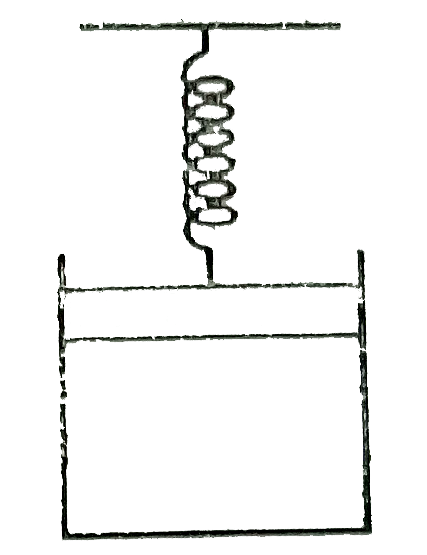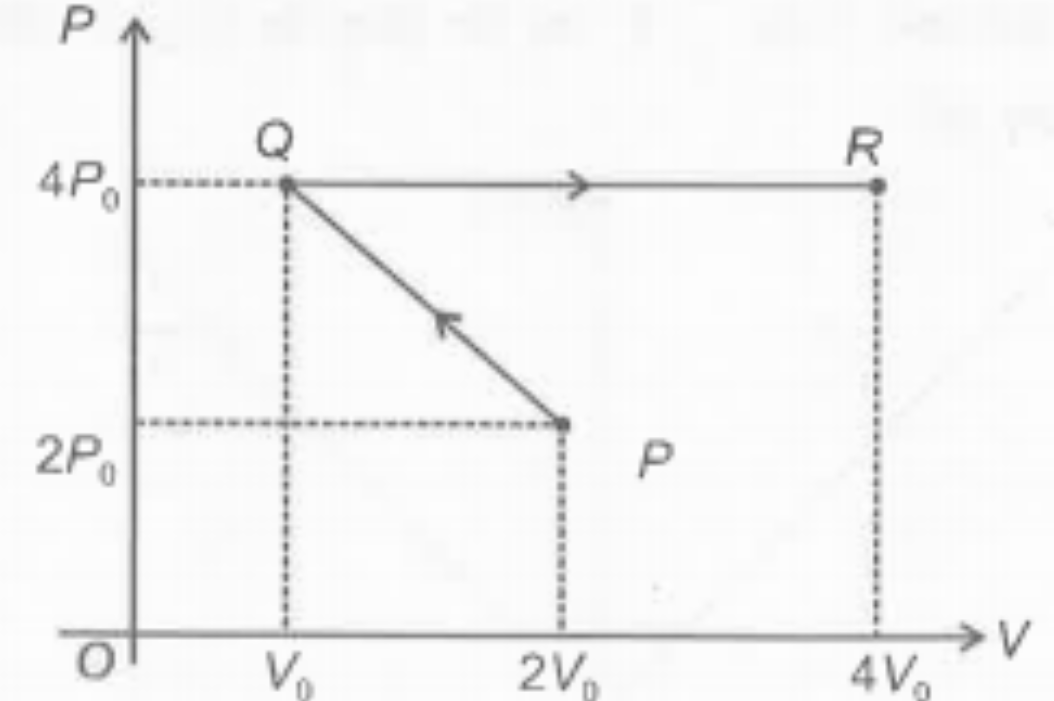During the expansion process the volume of the gas changes form 4m3 to 6m3 while the pressure change according to p=30V+100 where pressure is in Pa and volume is in m3. The work done by gas in N×102J. Find N.
The correct Answer is:5
To solve the problem, we need to calculate the work done by the gas during its expansion from a volume of 4m3 to 6m3 given the pressure-volume relationship p=30V+100.
1. Identify the Work Done Formula:
The work done W by the gas during expansion can be calculated using the formula:
W=∫V2V1PdV
where P is the pressure and V1 and V2 are the initial and final volumes, respectively.
2. Substitute the Pressure Equation:
From the problem, we have the pressure as a function of volume:
P=30V+100
So, we can substitute this into the work done formula:
W=∫64(30V+100)dV
3. Split the Integral:
We can split the integral into two parts:
W=∫6430VdV+∫64100dV
4. Calculate Each Integral:
- For the first integral:
∫30VdV=30⋅V22=15V2
Evaluating from 4 to 6:
15(62)−15(42)=15(36)−15(16)=540−240=300
- For the second integral:
∫100dV=100V
Evaluating from 4 to 6:
100(6)−100(4)=600−400=200
5. Combine the Results:
Now, we can combine the results from both integrals to find the total work done:
W=300+200=500J
6. Convert to Required Format:
The problem states that the work done is expressed as N×102J. We have:
500J=5×102J
Therefore, N=5.
Final Answer:
The value of N is 5.
The work done W by the gas during expansion can be calculated using the formula:
W=∫V2V1PdV
where P is the pressure and V1 and V2 are the initial and final volumes, respectively.
From the problem, we have the pressure as a function of volume:
P=30V+100
So, we can substitute this into the work done formula:
W=∫64(30V+100)dV
We can split the integral into two parts:
W=∫6430VdV+∫64100dV
- For the first integral:
∫30VdV=30⋅V22=15V2
Evaluating from 4 to 6:
15(62)−15(42)=15(36)−15(16)=540−240=300
∫100dV=100V
Evaluating from 4 to 6:
100(6)−100(4)=600−400=200
Now, we can combine the results from both integrals to find the total work done:
W=300+200=500J
The problem states that the work done is expressed as N×102J. We have:
500J=5×102J
Therefore, N=5.
The value of N is 5.
Topper's Solved these Questions
- KTG & THERMODYNAMICSBOOK - RESONANCE ENGLISHCHAPTER - KTG & THERMODYNAMICSEXERCISE - SECTION
138 Videos
- KTG & THERMODYNAMICSBOOK - RESONANCE ENGLISHCHAPTER - KTG & THERMODYNAMICSEXERCISE - Exercise-2
1 Videos
- KTG & THERMODYNAMICSBOOK - RESONANCE ENGLISHCHAPTER - KTG & THERMODYNAMICSEXERCISE - SECTION (J)
2 Videos
- KINETIC THEORY OF GASES AND THERMODYNAMICSBOOK - RESONANCE ENGLISHCHAPTER - KINETIC THEORY OF GASES AND THERMODYNAMICSEXERCISE - Exercise
64 Videos
- MAGNETIC FIELD AND FORCESBOOK - RESONANCE ENGLISHCHAPTER - MAGNETIC FIELD AND FORCESEXERCISE - Exercise
64 Videos
Similar Questions
Knowledge Check
The work done during the expanision of a gas from a volume of 4dm3 to 6dm3 against a constant external pressure of 3 atm is (1 L atm = 101.32 J)
A−6JB−608JC+304JD−304J
Pressure and volume of a gas changes from (p0V0) to (p04,2V0) in a process pV2= constant. Find work done by the gas in the given process.
View SolutionOne mole of an ideal gas is kept enclosed under a light piston (area =10−2m2) connected by a compresses spring (spring constant 100N/m). The volume of gas is 0.83m3 and its temperature is 100K. The gas is heated so that it compresses the spring further by 0.1m. The work done by the gas in the process is N×10−1J. Find N. (Take R=8.3J/K−mole) and suppose there is no atmosphere).

View SolutionThe work done during the expanision of a gas from a volume of 4dm3 to 6dm3 against a constant external pressure of 3 atm is (1 L atm = 101.32 J)
View SolutionThe pressure of a gas is 100 k Pa. if it is compressed from 1 m3 to 10dm3 , find the work done .
View SolutionThe volume of a gas expands by 0.25m3 at a constant pressure of 103Nm2. The work done is equal to
View SolutionA certain balloon maintains an internal gas pressure of P0=100kPa until the volume reaches V0=20m3. Beyond a volume of 20m3, the internal pressure varies as P=P0+2k(V−V0)2 where P is in kPa. V is in m3 and k is a constant (k=1kPa/m3). Initially the balloon contains helium gas at 20∘C, 100 kPa with a 15m3 volume. The balloon is then heated until the volume becomes 25m3 and the pressure is 150 kPa. Assume ideal gas behavior for helium. The work done by the balloon for the entire process in kJ is
View SolutionA sample of an ideal gas with initial pressure 'P' and volume 'V' is taken through an isothermal process during which entropy change is found to be DS. The work done by the gas is
View Solution

